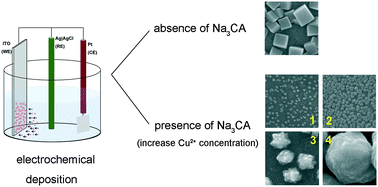Shape-, size-, and density-tunable synthesis and optical properties of copper nanoparticles†
Abstract
Copper nanoparticles (NPs) with a tunable shape (cube, hemisphere and agglomerate), size (42–146 nm) and density were synthesized on the ITO substrate by electrochemical deposition. SEM, TEM, SAED, XRD, XAES and UV-vis spectrophotometry were employed to characterize these nanoparticles. The important parameters including the capping agent, Cu2+ concentration, applied potential and deposition time were chosen to determine the final morphology and composition of the nanoparticles. Sodium citrate, served as the capping agent and reducing agent, absorbed selectively on Cu {111} faces instead of {100} faces, which affected the thermodynamic equilibrium in crystal growth, reduced aggregation and contributed to the synthesis of pure Cu NPs. The copper source, applied potential and deposition time affected the dynamic process, thereby controlling the nuclei number and growth rate. The optical properties of copper nanoparticles were studied by UV-visible absorption spectroscopy, and it was found that the intensity and position of the LSPR peak was strongly related to the shape, size and density of Cu NPs. Cu NPs with a tunable LSPR peak may be conducive to designing biosensors, catalysis, optoelectronic devices, etc.



 Please wait while we load your content...
Please wait while we load your content...